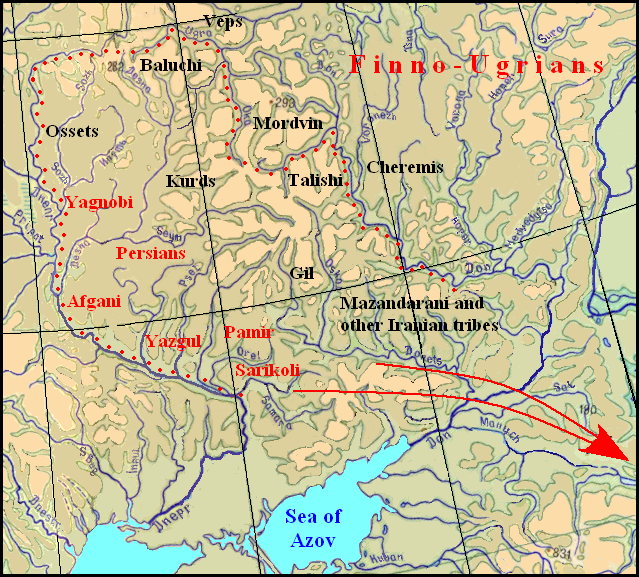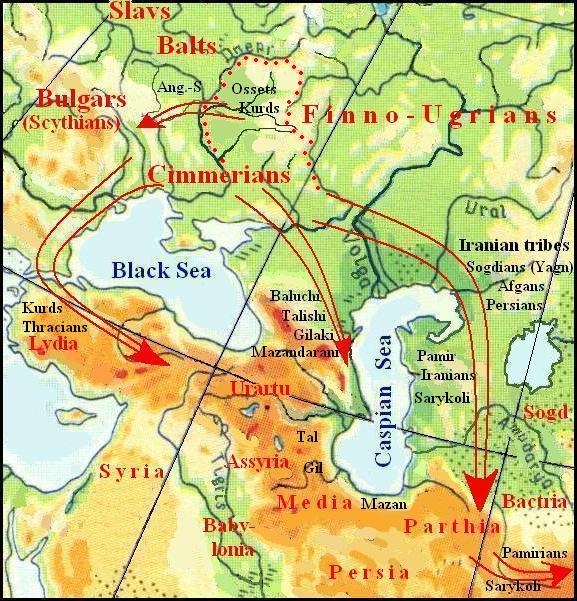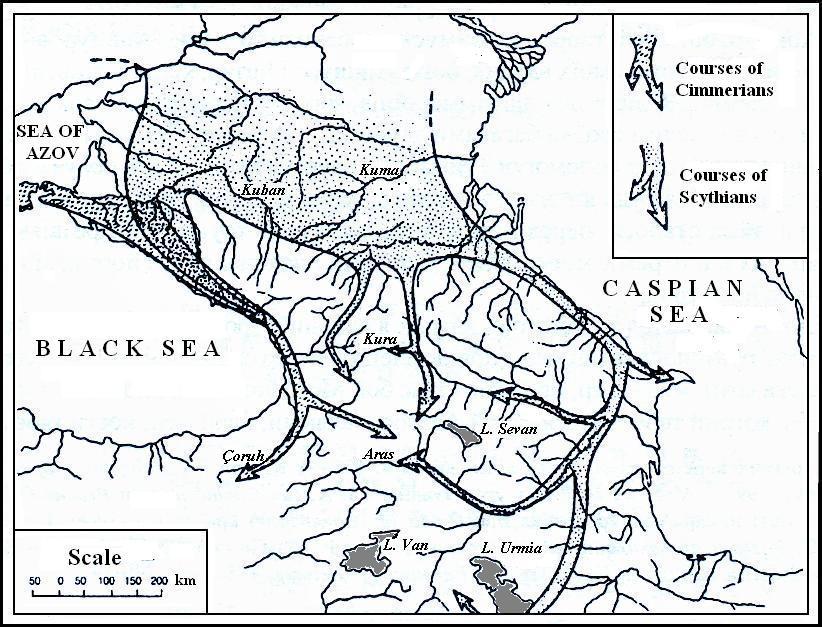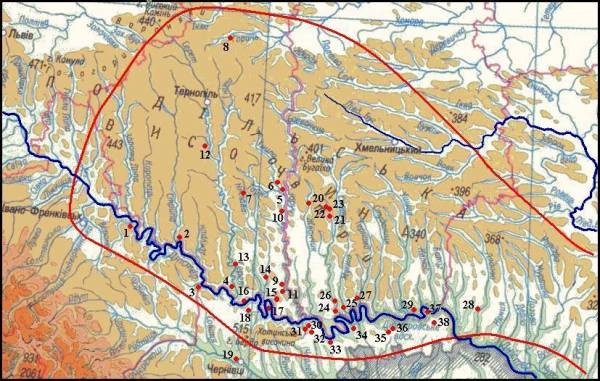|
Cimmerians
The penetration of the Balts and Anglo-Saxons on the left bank of the Dnieper initiated the motion of local Iranian population of the Zrubna culture. No doubt, other reasons forced Iranian people for searching new places of settlements, but the fact is so that Irano-Aryans appear already in the Central Asia at the end of the 2nd mill. BC:
Iranian names appeared in the Assyrian written sources in the 11-10th centuries. BC, and are associated with regions of Western Iran which were in the sphere of political activity of the Assyrian empire. What happened further east at this time – in the Central and Eastern Iran – is not reflected in these sources (ARTAMONOV M.I., 1974: 10).
There are two points of view about the ways of penetration of Iran-Aryans to the Near East – the way through Central Asia or the way through the Caucasus (PIANKOV I.V., 1979). At least the migration of Iran-Aryans in Asia Minor must have been going through the Caucasus (or even the Balkans), what is reflected in the Hittite sources (SOKOLOV S.N., 1979-2: 235). Obviously, the resettlement of Irano-Aryans went in several waves and paths, but the main path of movement of most of the Irano-Aryans lay along the eastern shore of the Caspian Sea and further along the Amu Darya and Syr-Darya River to the south and south east, as this is described by the E. Kuzmina (KUZ'MINA E.E., 1986: 203-204). but the path through the Caucasus could be used too. Nevertheless, the way through the Caucasus could be used too. Taking into consideration the location of residences of the modern Iranian peoples (EDELMAN D.I., 1968: the map 1) and their Urheimats in Eastern Europe, one may suppose that the Sogdians (the forefathers of the modern Yagnobi) moved as the last in the chain of migrants around of the Caspian Sea because they have occupied extreme northern part of the modern residences of Irano-Aryans in the Central Asia near to Afghans whom they adjoined on the Urheimat too. Their northern neighbours on the Urheimat, the Ossets populat the mountains of the Caucasus at present and, undoubtedly, never abandoned Eastern Europe. The territory of modern residence of the Kurd, the other neighbours of the Sogdians on the Urheimat, gives the reason to suppose, that they have come to these places by some other way, than the first wave of Irano-Aryans, namely, through the Caucasus or through the Balkans. If they would move around of the Caspian Sea, they should leave behind many other Iranian wandering groups what looks improbable. We have already noted that extension of the residence or the resettlement of ancient people went sequentially according to their mutual location on former habitats. As the forebears of the Kurd and the Sogdians had their areas in adjacency on the Urheimat, therefore, at the movement by the same way, their new residences should not be so far one from another as the areas of the Kurd and the Yagnobi are located at present. The most plausible way of the resettlement of the ancestors of the Gilaki and the Talishi to the southwest coast of the Caspian Sea, where they have their residences at present, was the way through the Derbent pass. First, it is the shortest way. Second, the Talishi residence is in the vicinity of the Gilaki’s habitat now and, was is very important, to the south of them, h.e. this is exact the same location as on the Urheimat. The disposition of their habitats had to be other if they would move by some other way. But whatever the migration path of the ancestors of the Kurd, Talyshi, and Gilaki to the Middle East we have reason to believe that until that time, they, as well as the ancestors of the Ossets, although they left their Urheimats under the pressure of the Balts, but still remained in Eastern Europe, when the most deal of the Irano-Aryans migrated to Asia. The ancestors of the Baluchi and Mazandarani belonged to this group of Iranian tribes whose languages belong to the same subgroup of the Iranian languages as Kurdish, Talyshi and Gilaki.

Right The beginning of the Iranian migration. The names of the tribes having formed the first wave of the migration are marked by red color.
Thus, we can assume that the first wave of Iranian immigrants in Central Asia was formed by the ancestors of the modern Saikolis, Pamir Iranians (Shugnans, Bartangs, Yazgulams, etc.), Persians, Afghans, and Sogdians (Yagnobi), ie that Iranian tribes which had their settlements in the southern part of the common Iranian territory and in areas along the Dnieper. Natural to assume that the left by them habitats were once occupied by other Iranian tribes, who for some time remained in Europe should be related to the historical Cimmerians which Iranian identity is recognized in science. The historically attested names of Cimmerian leaders (Teushpa, Ligdamis, etc.) being Iranian-looking make this more or less solidly grounded.

Left: General picture of the Iranian migration in Minor and Central Asia
It is believed that the Cimmerians (Cimmerii) came to the Black Sea region from Central Asia, or more generally – "from the depths of Eurasia," but this view is vigorously contested, therefore this topic has no sense to stop, especially as we know, where was the Urheimat of Irano-Aryans and the Cimmerians would have no time to migrate to Central Asia, and then back again. At the historically time Cimmerians settled Azov and Black Sea steppes, and left traces of their presence in the steppes of the Ukraine and North Caucasus in the numerous archaeological sites which are united in the common Cimmerian culture. It is logical to assume that it should continue the tradition of the Zrubna culture, which we identified as an Iranian (STETSYUK VALENTYN., 1998: 82-83) and this tradition is seen by Ukrainian archaeologists in the funeral rite of the Cimmerians:
The late Cimmerian culture developed in the tradition of the Zrubna culture… what can be traced in the funeral ceremony (Arkheologiya Ukrainskoy SSR., 1986: 23)
According to Assyrian sources, in the late 8th BC the king of Urartu Rus I was defeated in battle by the army of people Gimirrai that historians connect with the Cimmerians (MASON RICHARD, Ed., 2004: 13-15). In 679/678 the Cimmerians were defeated by the Assyrians their leader Teushpa was killed in that battle but nevertheless, later they attacked Phrygia, Lydia and Cilicia, where their new leader Ligdamis lost his life, as Strabo wrote (STRABON, 1964: I, 3).
Also later, during the first half of the 7th cen. BC all areas of Asia Minor were suffering by devastating raids of Cimmerians, who were sometimes joined for aggressive campaigns with the Thracians, moving to Asia Minor through the Balkans. Information about the campaign Cimmerians "from the Bosporus to Ionia" are present at Strabo, but for some reason he places this event at the time of Homer, or a little earlier (STRABON, 1964: I, 1-10).
There is uncertain evidence, obviously inspired by the same Strabo's message, about the presence of the Cimmerians in Hungary:
The presence In Hungary of some horse people, identified with the Cimmerians, is established on the basis of finds of bronze objects of harness and iron bridles, bronze boilers, weapons (swords and daggers). (SHUSHARIN V.P., 1971, 23).

Left: North Pontic region and Southwest Asia
in the era of the Cimmerian and Scythian migrations (VII-VI cen. BC)
(The map from MASON RICHARD, 2004, 27).
The doubt about Cimmerian appliance of finds are cased by possible penetration of Cimmerian products to the territory of Hungary along trade routes, as there was still the dominant Thracian culture. In the best case we can assume special Thracian-Cimmerian period from 750 to 550 years. BC(Ibid, 24).
However the fact is more important for our study that most of the Cimmerians came to the Southern Caucasus through Daryal gorge or Belorechenskiy pass but not through the Bosporus and the Dardanelles. Such a conclusion can be drawn from Assyrian sources as well from the testimonies of Bulgarian scholars about the absent visible Cimmerian traces in the Balkans (MELUKOVA A.I., 1979: 6). In 50-60 years after the appearance of the Cimmerians in Asia Minor the Scythians invaded here too. Passing through the Derbent, they settled in Azerbaijan and founded their kingdom between the rivers Kura and Araks, that is somewhere near the Lake Sevan. Only then they first encountered the Cimmerians which yielded them. Maybe the Scythians reached even to Iran. Middle Asian sources recall the Scythian kingdom in the late 90s of the 6th century BC, after which time no data in the history were found. It is believed that the bulk of the Scythians retreated back to the North Caucasus.

Northern Black Sea Region and Asia Minor in the VII-VI cen BC
(The map from MASON RICHARD, 2004, 21).
Taking into account the historical data and the results of our research, we can fairly confidently say that the common name of Cimmerians has to be connected first of all with the ancestors of the Talyshis and Gilakis, as well as the ancestors of akin the Baluchi and Mazandarani. Now the Baluchi dwell in Pakistan but we know that they came here from the southern coast of the Caspian Sea (FROLOVA V.A., 1960: 68; ORANSKIY I.M., 1979: 89)that is before (in the 5th to 6th cc. BC) their settlements were near the settlement of the Gilakis and Talyshes (the Mazandarani dwell in these places too).
The Chuvash language has quite a lot of words you can find a match in the Iranian languages or even just in a few of them, but the Chuvash-Kurdish lexical parallels are the most numerous. Table 15 shows some of them sometimes with matches in other Iranian languages:
Table 15. Chuvash-Kurdish lexical parallels
| Kurdish and other Iranian |
Chuvash |
| bet “a bustard” |
větel “woodkock” |
| kere “butter”, Gil kəre “butter” |
kěrě "fat" |
| kerdî “furrow” |
kěrche “wrinkled” |
| qarîk “a raven”, qarîtk “a partridge” |
karăk “a wood grouse” |
| qure “proud” |
küren “to be offended” |
| nar “fire”, Pers nar “fire” |
nar “blush” |
| pek “suitable” |
pek “like, similar” |
| sap “a ladle” |
sapa "basket" |
| saman “riches" |
semn “riches” |
| stûr “thich”, and other Ir. |
satur “strong” |
| soma “pupil of eye” |
săna “to observe” |
| sor “red”, Pers sorx “red” |
sără “paint” |
| sehre “sorcery, witchcraft” |
seхre "fear"; |
| semer “darkness” |
sěm “darkness” |
| çal “a pit”, Pers čal “a pit” |
çăl “a well, source” |
| çîrt “pus” |
çěrt “to let rot” |
| çîban “a pimple” |
çăpan “a furuncle” |
| çêl “a cow” |
çile“un udder” |
| tar “a pole” |
tar “a poplar” |
| taw “a downpour” |
tăvăl “a storm” |
| tobe “an oath” |
tupa “an oath” |
| toraq “cheese” |
turăx “fermented baked milk” |
| xumar “morose”, xumari “darkness” |
xămăr “brown” |
Without a doubt, the forefathers of the Kurds and Bulgars were living in close proximity for a long time. While analyzing place names of the Ukraine it was appeared that many of them particularly in the West Ukraine can be explained by means of the Kurdish language (see "Iranian Place Names in the Ukraine"). Formerly, a certain part of the Scythian Onomasticon was explained using Kurdish (STETSYUK V.M., 1999: 89-93; STETSYUK VALENTYN. 2000: 23-28). All this leads to the assumption that some part of the Scythian people spoke a Proto-Kurdish language, which for convenience we shall henceforth call simply Kurdish.
The presence of the ancient Kurds on the Dnieper right bank immediately raises the question of which way they got there. According the general movement of the Iranian tribes from their initial settlements between the Dnieper and the Don eastward and southeastward, it can be assumed that the ancestors of the Kurds came to the Azov steppes, and from there crossed the Dnieper and later moved northwestward, displacing more ancient settlers, the Thracians to the south-west and the Bulgar to the west. The band of Kurdish settlements from the town of Gaysin and further along the Dniester River on the west may mark the path, but the presence of names of Kurdish origin in Chernigov, Kiev and Zhitomir Regions gives warrant to consider an option when the ancestors of the Kurds from their Urheimat went with downstream of the river Desna to the Dnieper, crossed it and moved westward. This migration could last a long time, and some part of the inhabitants of new sites retained, when other went away. They could keep the names of villages and rivers for a long time.
By itself, an amazing fact of preservation to this day the names of ancient Kurdish settlements can not help us in determining the time frame of dwelling the Kurds in the Western Ukraine, but they are unlikely to participate in those raids to the South Caucasus in the late 8th and early 7th centuries BC mentioned above. However, the reason to refer also the Kurd to the Cimmerians exists. The Kurd ancestors as Cimmerians could perform the raids to Asia Minor together with Thracians through the Balkans. Their self-name "Kurmanj" includes the root which is somewhat like to the name of the Cimmerians "Cimmer". The same root may be the name of the town Zhmerynka in Vinnytsia Region, where Kurdish place names just kept in a large number.
It is in those places along the reaches of the Middle Dniester, where an accumulation of Kurdish place names was noted, treasures of gold objects were found in the village of Mikhalkiv Ternopil region on the right bank of the Nichlavy twice, in 1878 and 1897. The hoards are dated by the 6th c. BC ie they are older in two centuries than the finds from the famous Scythian kurgans Kul Oba and Chertomlyk. The whole treasure weighing over seven pounds consisted of a diadem, a torque, five bracelets, 12 brooches, seven plaques, pyramidal pendant, four bowls and other items (PETROVS'KIY OLEKSANDR., 1993: 8). M.I Artamonov thought that some subjects of Mikhalkiv treasure and finds from the kurgan Vysoka Mohyla (High kurgan) the village of Balky of Vasilkiv district of Zaporozhye Region had a certain similarity wrote:
This strengthens the relationship of so-called Cimmerian culture with the Carpatho-Danube Hallstatt and reinforces the hypothesis of the origin of this culture on the basis of forms widened in the northern Black Sea region is not from the North Caucasus but from Central Europe, and North Caucasus itself was in the area of their existencen (ARTAMONOV M.I., 1974: 34).
Thus, the band of Kurdish settlements along the Dniester can evidence about the moving of the Kurds not from the steppes but to the steppes of the right-bank Ukraine, where from they could make their raids to Asia Minor together with the Thracians. There they participated in a variety of wars, including in alliance with the Scythians, but after the defeat of Lydia supported by them in the war against Media and New Babylonia the Cimmerians and Scythians had to go there where they came from, ie in the Northern Pontic Region. According the terms of peace agreement there was no place for them in Asia Minor (Ibid). The farther fate of the Cimmerians was defined by M.I Artamonov, based on the archaeology of Kuban kurgans of Scythian time, so:
Settling in Maeotian country, the Cimmerians due to their higher culture and the organization took leading position in the Kuban region, but remaining in the minority, were unable to preserve their ethnic identity and eventually merged with the native population. It is possible that the direct descendants of the Cimmerians were Cindies represented the most progressive part of the population of the Lower Kuban – the Taman Peninsula and the adjacent part of the Black Sea coast (ARTAMONOV M.I., 1974: 62).
The fact that the Cimmerians could really populate the Kuban area, said the fixed ethnonym Δανδαριοι (the name of a people at Low Kuban and the Maeotia). As the lower part of the Kuban region lies between the Azov and Black Seas, Kurd. derya/darya "sea" and dan "inside", ie, "surrounded by the sea" suits perfect for explaining the name of this people.
However, the majority of Kurds-Cimmerians stayed in Podolia. At some time, the Polish professor Tadeusz Sulimirsky allocated West Podolsky local group among the sites of the early Scythian time. Its specific features are as follows:
… the use of stone in conjunction with a tree in the construction burial chambers; complete absence of horses accompanying the dead in burial graves ; frey pottery, existed only in the area of the Scythian forest-steppe; the use of certain types of jewelry, unknown or little known in other regions… (SMIRNOVA GALINA IVANOVNA, 2004: 419)

At left:
Sites of Western Podolian Group of Early Scythian Time
The map is composed on the data of Galina I. Smirnova (SMIRNOVA GALINA IVANOVNA, 2004: 411, Fig.1)
The red line drows around the aglomeration of place names os Kurdish origin in Podolia.
These sites are marked by numbers: 1. Bratyshiv. 2. Beremiany. 3. Horodnytsia. 4. Lysychnyky. 5. Rakiv Kut. 6. Novisilka of Hrymayliv. 7. Sukhostav. 8. Myshkivtsi. 9. Nyvra. 10. Shydlivtsi. 11. Zalissia. 12. Ladychyn. 13. Bilche Zolote. 14. Sapohiv. 15. Ivane Puste. 16. Zozulyntsi. 17. Perebykivtsi. 18. Vikno. 19. Novosilka (near Chernivtsi). 20. Ivakhnivtsi. 21. Zavadyntsi. 22. Servatyntsi. 23. Skipche. 24. Shutkivtsi. 25. Tarasivka. 26. Verkhni Panivtsi. 27. Vrublevtsi. 28. Verkhniy Olchedaiv. 29. Loyivtsi. 30. Dolyniany (kurgans). 31. Dolyniany (settlement). 32. Kruhlyk. 33. Oselivka. 34. Lenkavtsi. 35. Ivanivtsi. 36. Selyshche. 37. Neporotiv. 38. Bilousivka.
Partial congruence of spread areas of sites ofs Western Podolia groups and Kurdish place names suggests that these sites were left by Kurds, that is some part of the population of the area stayed a certain time on the previous settlements. Later this part of Kurds moved to Central Europe (see section Cimbri).
Long presence of Cimmerian Kurds on Ukraine is confirmed by Slavic-Iranian Language Connections Words of Kurdish origin in the Ukrainian language, which have no correspondence in the other Slavic languages, evidence that some part of the Kurds remained on Ukrainian territory until arriving here Slavs. The Northern Black Sea epigraphy same say the same, so the Kurd can be related to some of the nations mentioned by ancient historians, including Herodotus. Apparently, such people could be Alazonians which Herodotus placed something south from the Scythians tilling the ground, in the locality where the Tyras (Dnister) and the Hypanis (Southern Bug) approach one another in their windings. There is just in this place the greatest concentration of Kurdish place names (see map above, where the two rivers highlighted in blue)
Herodotus, speaking of the myths and beliefs of the Scythians, dindn’t mention of the cult of fire, wheels, and chariots, always present in the beliefs of various Iranian tribes. It is doubtful that the Scythians, being of Iranian origin, could radically change their beliefs. Therefore the absence at the Scythians these cults gives an additional argument against identifying them with the Iranians. However, the Iranian element, if not among the Scythians, then, at least among the different population of Scythia is present. We have seen that the Petrov’s Onomastikon has Iranian matches mostly from the Kurdish language (about six dozen). At the same time more than twenty words of Onomastikon have counterparts only in the Kurdish language, and some of them well-suited for anthroponymy (see Αβαβοσ, Αβλωνακοσ, Διζα-Ζελμισ, etc). Keeping in mind that Onomastikon could have not only Scythian words, we can say with certainty about the presence of Kurds in the South of Ukraine in the late first millennium BC and early first millennium AD We identified the Kurds with the Alazonians of Herodotus, which he located just south of the Scythians-plowmen. Farther to the south, according to Herodotus, the Callipidai lived, which were characterized by him as Hellenic Scythians. Perhaps they were the descendants of those Proto-Greeks who stayed in the Black Sea, where most of them migrated to the Balkans.
| |

















